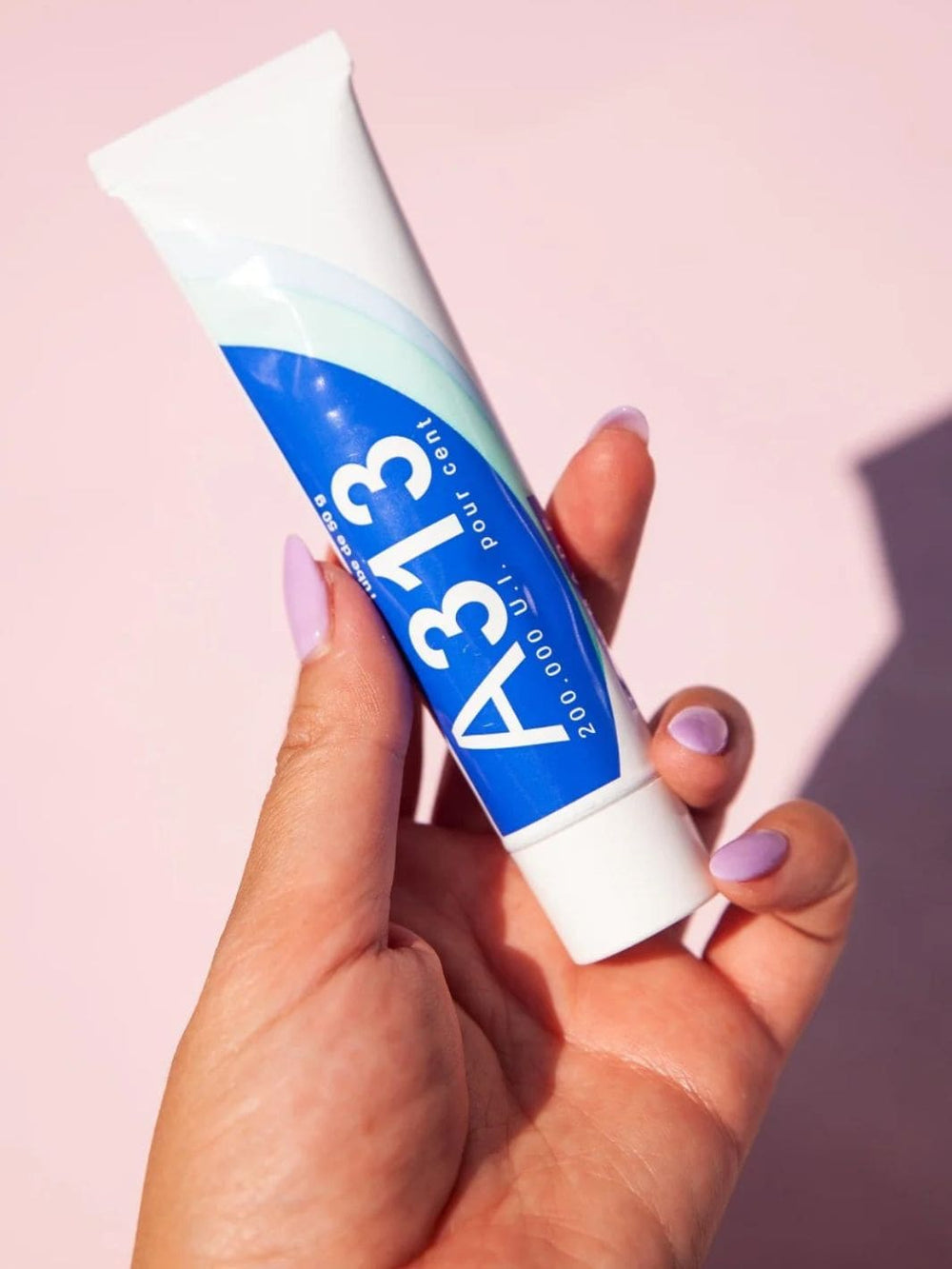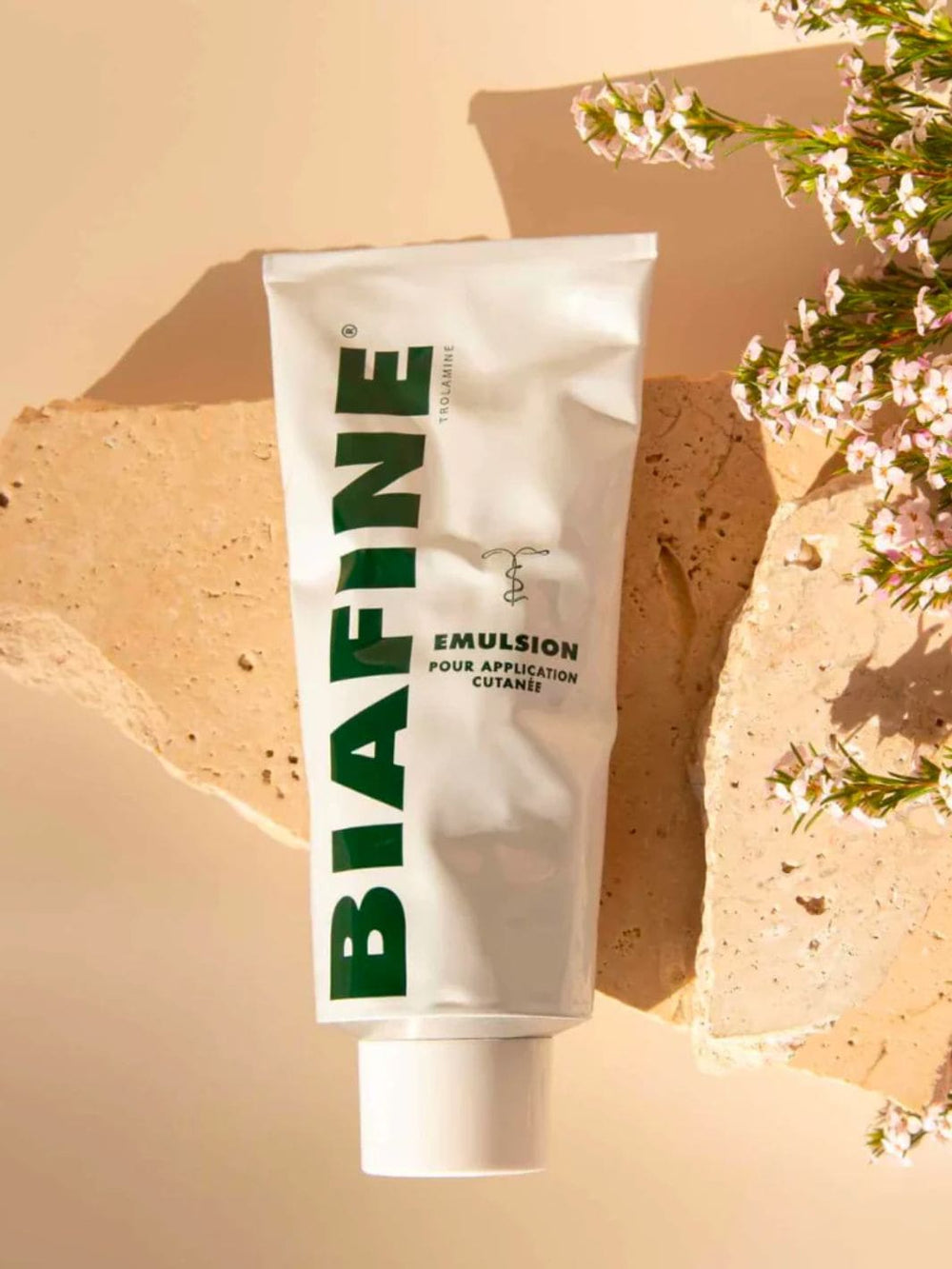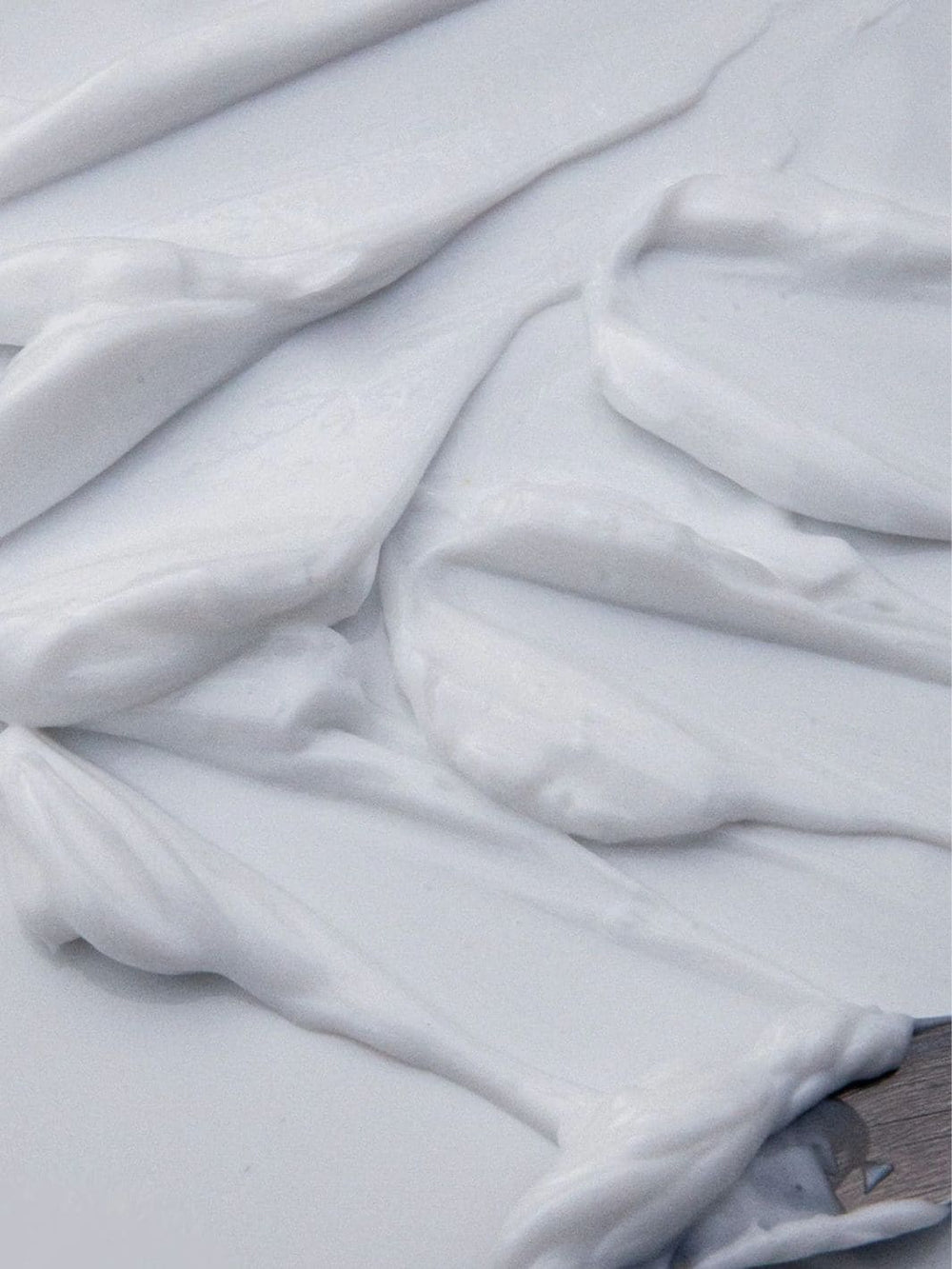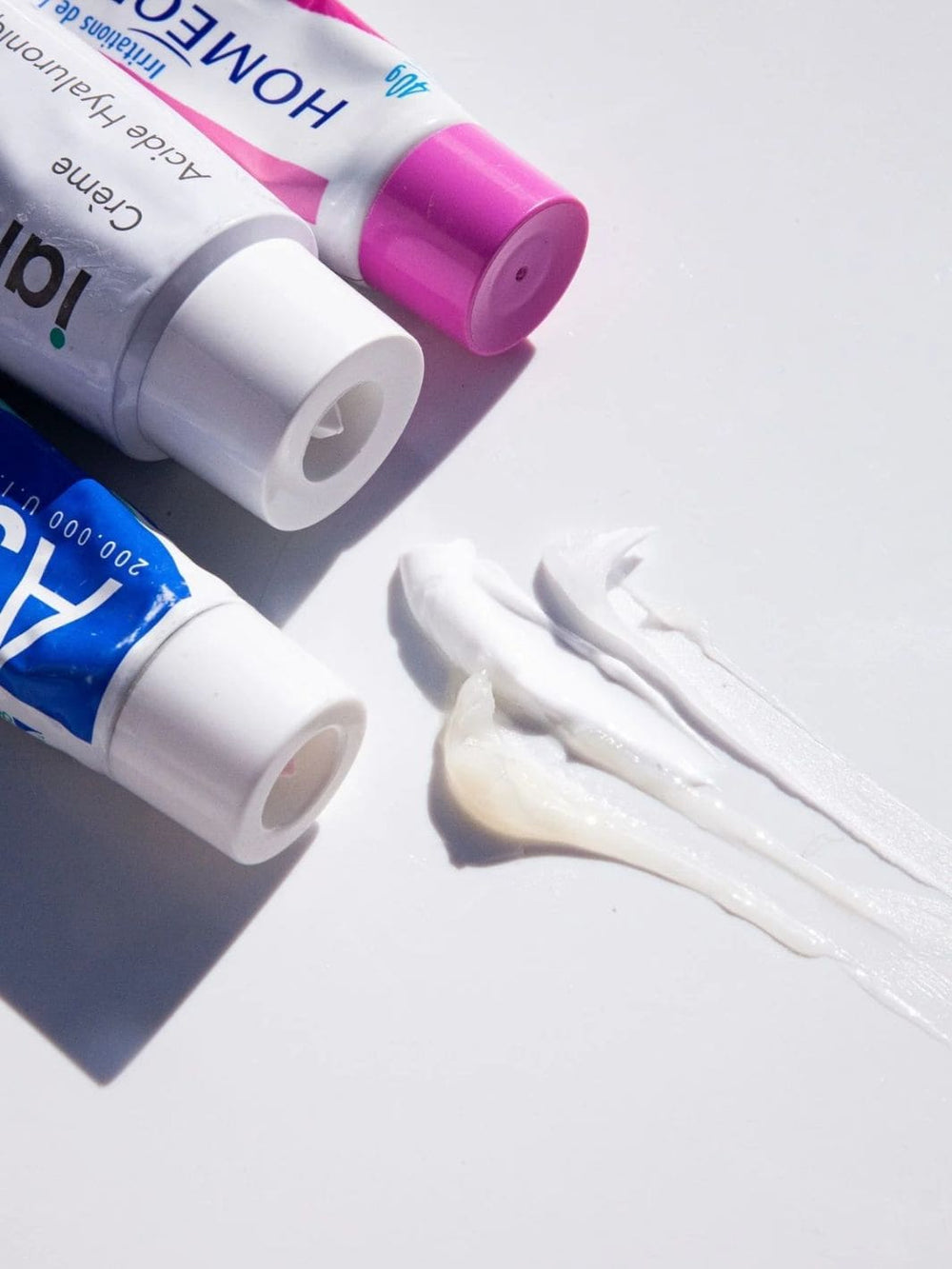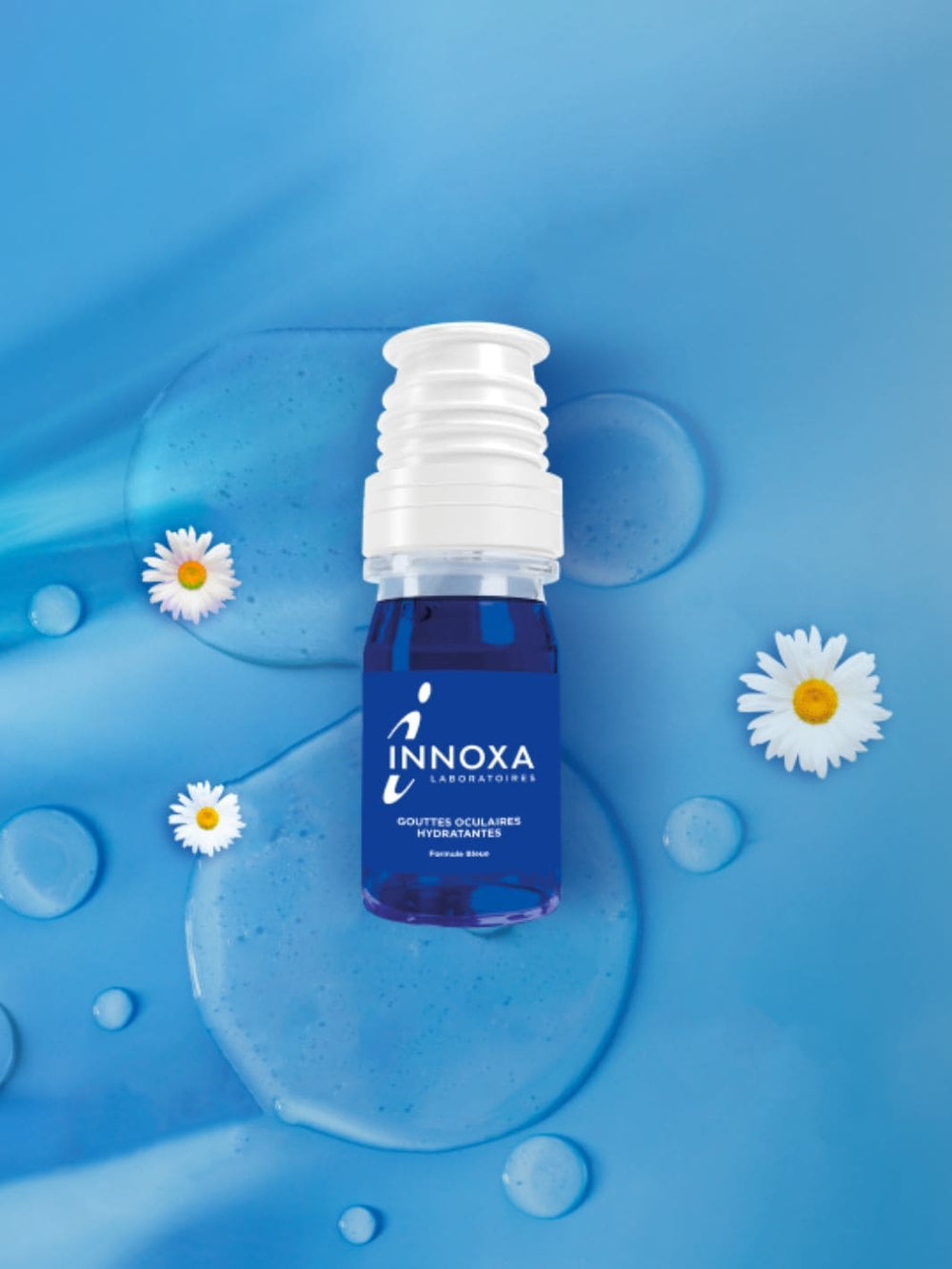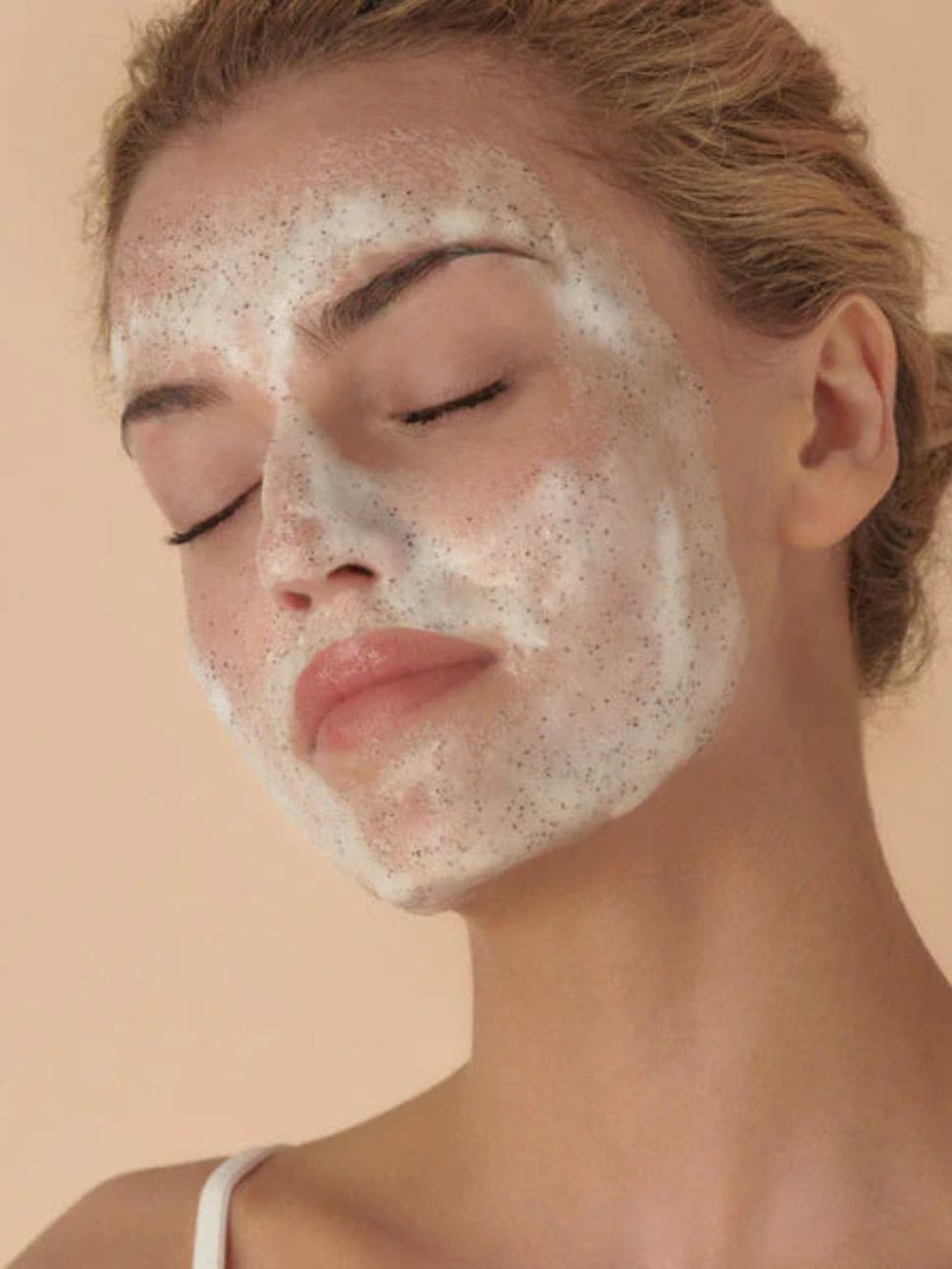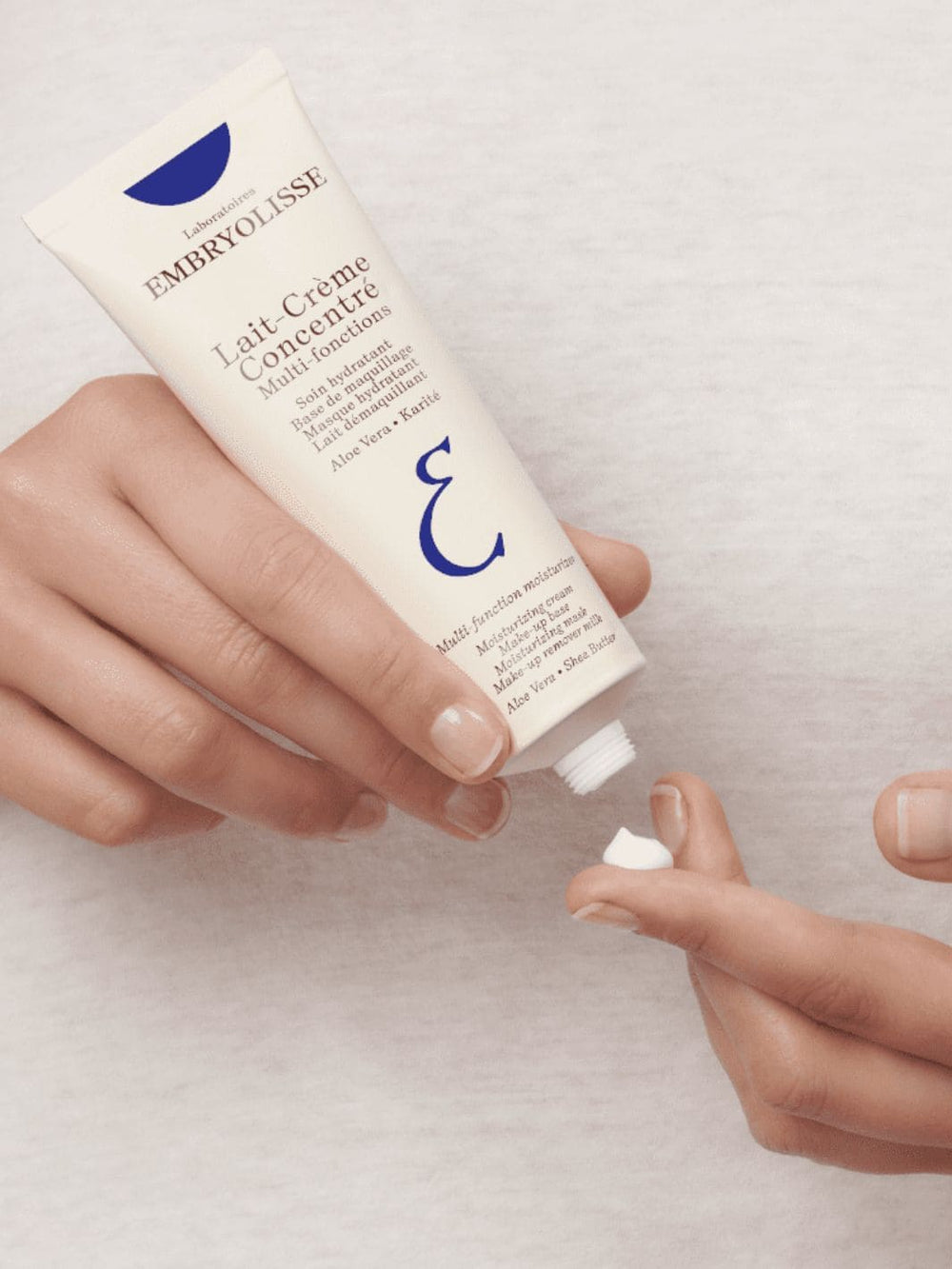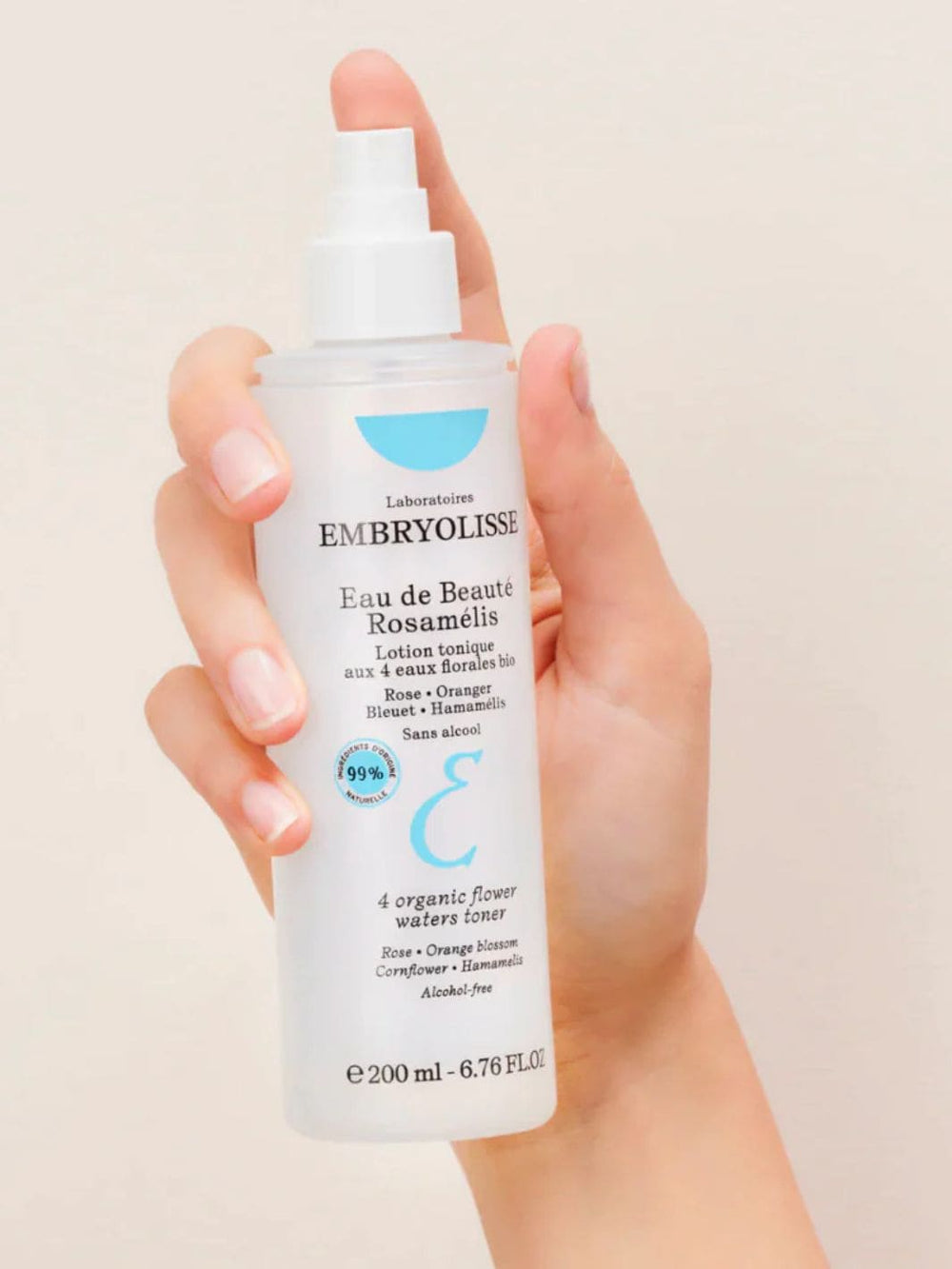The Ultimate Guide to French Skincare - Biafine & A313
French Skincare earns its glowing reputation thanks to a blend of timeless traditions, high quality ingredients, and a philosophy centered on simplicity and effectiveness. Passed down through generations and highly coveted among makeup artists from all over the world, what sets it apart is a “less-is-more” approach; it's not about overwhelming ingredient lists but rather a focus on a few exceptional ingredients.
Beyond fixing issues, French Skincare focuses on prevention, foreseeing skin concerns before they even surface. And because the French are known for their style and flair, you won’t expect anything less than a luxurious experience from using their products. We are going to break down the secrets to French Girl Beauty with beloved cult favorites like A313, Ialuset, Homeoplasmine and Biafine—formulations that combine care and deliver real results.

Biafine: The Soothing Saviour
Initially designed as a cream to treat burns, wounds, and scars, skincare enthusiasts discovered this wonder product isn’t just for emergencies. It’s a must-have for anyone dealing with irritated or sensitive skin. Formulated in a creamy, soothing texture, Biafine is like a comforting hug for skin woes, from sunburns to post-procedure care. Plus, it doubles as an incredible hydrating mask for instant radiance.

HOW DO I USE BIAFINE?
Typically known for its healing properties for burns and scars, can be used as a skincare product to boost hydration and nourishment. After cleansing your face, take a small amount of Biafine and gently massage it into your skin, avoiding the eye area and focusing on areas that need extra moisture. You can incorporate it into your routine as a daily moisturizer or use it a few times a week, depending on your skin's needs. If you prefer a more intensive treatment, apply a thicker layer before bedtime and leave it on as an overnight mask to deeply hydrate your skin. Remember to avoid the eye area and, if using during the day, follow up with sunscreen to protect your skin. Incorporating Biafine into your skincare routine can provide an extra layer of hydration, leaving your skin feeling nourished and moisturized.
IS BIAFINE SAFE FOR SENSITIVE SKIN?
Biafine is generally considered safe for sensitive skin due to its gentle formulation. Its primary purpose is to soothe and aid in the healing of irritated or damaged skin. Many individuals with sensitive skin find Biafine helpful in providing relief from redness, dryness, and discomfort.
Twentyseven Tip: We LOVE Biafine on vacation, after a day of soaking in the sun, Biafine rehydrates and soothes your skin. Trust us. Don't leave this behind when you go on vacation.

A313: The Game Changing Retinoid Cream
Picture this: a magical potion that can do it all! A313 is often hailed as the French secret to youthful skin - the key to that Benjamin Button lifestyle. Formulated as a vitamin A pomade, it's essentially a retinoid cream that works wonders on fine lines, wrinkles, and even acne. But here's the real shocker—it's gentle enough for sensitive skin too! Containing retinyl acetate, a less potent but still effective form of retinoid, making it a perfect introduction for those new to the retinol game.
HOW DO YOU USE A313?
Start with a pea-sized amount for your entire face. Begin by using it sparingly, maybe once or twice a week, to allow your skin to acclimate to the retinoid. Gradually increase the frequency as your skin adjusts. Apply a thin layer in the evening, after cleansing and toning, and before moisturizing.

WHAT’S THE DIFFERENCE BETWEEN RETINOL AND RETINOIDS?
Retinol and Retinoid are often used interchangeably, but mean different things. For one, Retinoids are a broader class of compounds that include both prescription-strength and over-the-counter forms. They contain a higher concentration of the product, are more potent and encompass various vitamin A derivatives like tretinoin, adapalene, and tazarotene. Retinoids allow for faster skin cell turnover. Retinol is a milder form of retinoid commonly found in over-the-counter skincare products containing a lower concentration of the product. It works similarly to its more potent relatives by aiding in skin renewal, boosting collagen production, and diminishing the appearance of fine lines and wrinkles. While it's gentler, it still offers skin-renewing benefits, although it might take more steps to work and see results.
Is A313 Retinol or Retinoid?
A313 is a product that contains a form of vitamin A called retinyl acetate, which is a type of retinoid. Therefore, A313 is a retinoid-based skincare product, not just retinol. Retinoids, including retinyl acetate, are known for their fast acting skin-renewing properties and their ability to address various skin concerns such as fine lines, wrinkles, and acne.

GENERAL QUESTIONS ABOUT A313
HOW LONG DOES A313 TAKE TO WORK?
All retinoids, including A313, will start working right away. But most people will probably go through an initial adjustment period involving dryness, itching and/or irritation. This is called “retinization,” and it typically lasts about four to six weeks.
Short-term effects: Some might notice changes in skin texture or a slight improvement in acne within a few weeks of using A313. Skin might feel smoother or look more radiant initially.
Long-term effects: More significant changes, like reduction in fine lines, wrinkles, and improvements in skin tone and texture, typically become noticeable after consistent use over several months. Retinoids work by increasing cell turnover, which takes time to manifest visible changes in the skin.
Adjustment period: When starting A313, there might be an adjustment period where the skin experiences dryness, flakiness, or mild irritation. This can happen in the initial weeks of usage as the skin adapts to the retinoid. Gradually introducing the product and using it every few days before increasing frequency can help mitigate these effects.
Consistency is key with retinoid-based products like A313. It’s essential to use it regularly as recommended and follow a skincare routine that includes sun protection during the day to maximize its benefits and minimize potential irritation.
IS IT NORMAL FOR MY SKIN TO ITCH/GET IRRITATED AFTER USING A313?
Experiencing skin irritation when using products containing retinoids, like A313, is common, especially when starting with a new retinoid or using it more frequently. Your skin might need time to adjust to the potent ingredients.
Using A313 too frequently or applying too much product initially can lead to increased irritation. It's recommended to start with a small amount and gradually increase usage as your skin gets accustomed to it. Retinoids can cause dryness as they increase skin cell turnover. Ensuring adequate hydration by using a gentle moisturizer alongside A313 can help mitigate this.
CAN YOU MIX A313 WITH MOISTURIZER?
Yes, you can mix A313 with moisturizer to dilute its potency and potentially reduce the risk of irritation, especially if you're new to using retinoids or experiencing sensitivity.
Here’s how to do it:
- Start with a small amount: Take a pea-sized amount of your moisturizer on your palm.
- Add a small dab of A313: Mix in a tiny amount (around a pea-sized or less) of A313 into the moisturizer.
- Blend thoroughly: Mix the two products together thoroughly in your palm before applying it to your face.
This method can help distribute the retinoid more evenly across your skin, making it easier for your skin to adjust to the retinoid while also providing hydration. It can be particularly helpful if you're experiencing dryness or irritation from using A313 alone.
SHOULD I USE SUNSCREEN ON TOP OF A313?
Yes, we definitely recommend using sunscreen during the day after using A313 or any other retinoid product. Retinoids can increase skin sensitivity to the sun, making your skin more prone to damage from UV rays. Using sunscreen helps protect your skin from harmful effects such as sunburn, premature aging, and potential long-term damage, especially when using retinoids that can make your skin more photosensitive. Choose a broad-spectrum sunscreen with an SPF (Sun Protection Factor) of 30 or higher and apply it as the last step of your morning skincare routine. Reapply sunscreen every two hours, especially if you're spending extended periods outdoors or engaging in activities that might cause sweating or swimming.
DOES A313 CAUSE PURGING?
If you are acne-prone and new to retinoids, then your skin may purge when you first start A313. Purging is an initial acne breakout that can occur when using a new treatment that increases skin cell turnover. If you can suffer through it—it usually lasts about a month—purging is actually a good thing because it’s bringing up the clogged sebum that was trapped under your skin surface.

Boiron Homeoplasmine: The Multi-Tasking Essential
Homeoplasmine is a must-have in any French skincare lover's routine. This multi-use balm is perfect for soothing dry, irritated, or chapped skin while promoting hydration and repair. Beloved by makeup artists and skincare enthusiasts alike, it’s the ultimate secret weapon for a smooth, radiant complexion.
BENEFITS OF HOMEOPLASMINE:
- Soothes irritation: Calms redness and discomfort on sensitive or chapped skin.
- Deeply hydrates: Repairs dry areas for a soft, smooth finish.
- Multipurpose use: Perfect for lips, dry patches, and even prepping skin for makeup.
- Non-greasy formula: Absorbs quickly, leaving no heavy residue.
HOW TO USE HOMEOPLASMINE:
- As a lip balm: Apply a small amount to dry, chapped lips for instant relief.
- Spot treatment: Dab onto dry or irritated areas, such as elbows, knuckles, or around the nose.
- Makeup prep: Use sparingly as a base for smoother lipstick or foundation application.
CAN HOMEOPLASMINE BE USED WITH A313, BIAFINE, OR IALUSET?
Yes! Homeoplasmine works seamlessly with other French skincare products:
- With A313: Use Homeoplasmine after A313 to target dry patches and soothe any irritation from retinoid use.
- With Biafine: Apply Biafine for overall skin hydration, followed by Homeoplasmine on problem areas.
- With Ialuset: Pair Ialuset for all-over hydration, then layer Homeoplasmine on specific dry spots for extra care.
COMMON QUESTIONS ABOUT HOMEOPLASMINE:
CAN I USE HOMEOPLASMINE DAILY?
Yes! Homeoplasmine’s gentle formula is specifically designed to be safe for everyday use, making it an essential addition to your skincare routine. Whether you're using it to heal chapped lips, soften dry patches, or calm irritation, its non-greasy and lightweight texture ensures it won’t feel heavy or clog pores. Daily use is especially beneficial during colder months or in dry climates, where skin tends to need extra care. Apply as needed throughout the day, focusing on areas prone to dryness or discomfort for consistently nourished and healthy-looking skin.
IS HOMEOPLASMINE SAFE FOR SENSITIVE SKIN?
Absolutely. Homeoplasmine was created with irritation-prone skin in mind, making it a trusted solution for those with sensitivity. Its minimal ingredient list ensures it soothes without causing further aggravation or reactions. It's an excellent choice for calming redness caused by environmental factors, like cold weather or allergies, and can even be used after minor skin treatments to reduce discomfort. If your skin often reacts poorly to new products, Homeoplasmine’s dermatologist-recommended formula is a gentle and reliable option.
CAN I WEAR HOMEOPLASMINE UNDER MAKEUP?
Yes! Homeoplasmine is a favorite among makeup artists for its ability to hydrate and prep the skin for a smooth application. Its non-greasy finish creates the perfect base, especially for areas that tend to dry out and cause makeup to crack or flake. Apply a thin layer to lips before lipstick to prevent dryness or dab it onto rough patches to ensure an even foundation application. Just give it a minute to absorb before layering your makeup, and you'll find that your skin looks radiant, hydrated, and ready to hold your look all day.
CAN I USE HOMEOPLASMINE WITH SUNSCREEN?
Yes! You can safely use Homeoplasmine with sunscreen. After applying Homeoplasmine to hydrate and protect dry or irritated areas, wait a few moments for it to absorb, then apply your sunscreen. This ensures your skin is well-moisturized and protected from UV damage.

Ialuset: Hydration Hero
Ialuset is the French skincare solution for anyone seeking plumper, more hydrated skin. Packed with hyaluronic acid, this versatile product deeply moisturizes, smooths fine lines, and enhances your skin’s natural glow. Whether you're dealing with dryness or just want a boost of hydration, Ialuset delivers results that last.
BENEFITS OF IALUSET:
- Deep hydration: Infuses the skin with moisture, leaving it soft and plump.
- Anti-aging benefits: Reduces the appearance of fine lines and wrinkles over time.
- Supports healing: Helps repair and soothe irritated or post-treatment skin.
- Versatile application: Ideal for daily use, masks, or targeting dry areas.
HOW DO I USE IALUSET?
Ialuset is incredibly easy to incorporate into your routine:
- Daily Hydration: After cleansing, apply a thin, even layer to your face, avoiding the eye area. Follow up with your usual sunscreen or night cream.
- As a Mask: For an intense hydration boost, apply a generous layer to your face and leave it on for 10–15 minutes. Gently remove any excess with a tissue or cotton pad.
- Post-Treatment Care: Use after active treatments like A313 or chemical exfoliants to replenish lost moisture and calm the skin.
Always use Ialuset on clean skin to maximize its hydrating effects. Apply morning and night as needed to keep your skin looking its best.
CAN IALUSET BE USED WITH A313, BIAFINE, OR HOMEOPLASMINE?
Yes! Ialuset complements other French skincare favorites beautifully:
- With A313: Use Ialuset after applying A313 to hydrate and counteract any dryness.
- With Biafine: Layer Ialuset first for hydration, followed by Biafine for extra soothing.
- With Homeoplasmine: Apply Ialuset all over, then Homeoplasmine on localized dry areas for targeted relief.
COMMON QUESTIONS ABOUT IALUSET:
CAN I USE IALUSET DAILY?
Yes! Ialuset’s hyaluronic acid-based formula is gentle enough for daily use, offering deep hydration and plumping effects that enhance your skin’s texture and overall appearance. Incorporating it into your routine every day helps maintain optimal moisture levels, making it particularly effective for combating dryness, fine lines, and dullness. Whether applied as a hydrating mask or a targeted treatment, consistent use ensures your skin stays nourished, smooth, and radiant, making Ialuset a must-have for your daily skincare ritual.
IS IALUSET SAFE FOR SENSITIVE SKIN?
Absolutely. Ialuset is specially formulated with pure hyaluronic acid, known for its soothing and hydrating properties, making it ideal for even the most delicate skin types. It works gently to replenish moisture and support the skin's natural barrier without introducing harsh chemicals or irritants. Perfect for addressing issues like redness, dryness, or irritation, Ialuset helps sensitive skin regain its balance and softness. Its hypoallergenic and non-comedogenic formula makes it a trusted choice for anyone seeking gentle yet effective hydration.
CAN I WEAR MAKEUP OVER IALUSET?
Yes, Ialuset is an excellent base for makeup application. Its lightweight, hydrating formula absorbs quickly into the skin, leaving behind a smooth, plump canvas perfect for foundation, concealer, or any other makeup products. By deeply moisturizing the skin, Ialuset helps prevent makeup from clinging to dry patches or settling into fine lines, ensuring a flawless finish. For best results, apply Ialuset, let it fully absorb, and then follow with your primer or sunscreen before applying makeup. This makes it a versatile addition to your routine for both skincare and makeup prep.
IS IALUSET ONLY FOR FACIAL USE?
Not at all! While Ialuset is a popular choice for facial care, its versatile formula makes it suitable for use on other areas of the body that need extra hydration and care. Apply it to dry hands, elbows, knees, or any areas prone to dehydration or roughness. Its hyaluronic acid content helps restore moisture and improve skin elasticity, making it a go-to for addressing dryness anywhere. Whether it’s calming post-shave irritation, soothing cracked heels, or hydrating dry cuticles, Ialuset proves it’s not just limited to facial care.
CAN I USE IALUSET WITH SUNSCREEN?
Absolutely! Ialuset can be used with sunscreen. After applying Ialuset to hydrate and plump the skin, allow it to absorb before applying sunscreen to protect your skin from harmful UV rays. This combination ensures optimal hydration and sun protection for your skin.
WHAT’S THE DIFFERENCE BETWEEN BIAFINE AND A313?
WHAT’S THE DIFFERENCE BETWEEN BIAFINE, A313, IALUSET, AND HOMEOPLASMINE?
A313, Biafine, Ialuset, and Homeoplasmine might seem like they deliver similar results, but they serve distinct purposes, making them versatile staples in French skincare. Here's how they differ:
A313:
- Purpose: A313 is a vitamin A-based skincare product that contains retinyl palmitate, a form of vitamin A or retinoid.
- Usage: It's commonly used for its potential anti-aging properties, aiding in skin renewal, reducing fine lines, and improving skin texture.
Biafine:
- Purpose: Biafine is a soothing and healing cream often used for wound healing, burns, and skin irritations.
- Usage: It's used to soothe and aid in the healing of damaged or irritated skin, providing relief from redness, dryness, and discomfort.
- Ingredients: Biafine contains a mix of ingredients like liquid paraffin, squalane, and glycols, focused on providing a soothing effect and supporting skin healing.
- Twentyseven Tip: We love taking Biafine on vacation with us, after a day in the sun Biafine will soothe dry dehydrated skin and heal any sunburns almost immediately..
Ialuset:
- Purpose: Ialuset is a hydrating powerhouse featuring hyaluronic acid, known for its ability to plump the skin and restore moisture.
- Usage: It’s perfect for addressing dehydration, improving skin elasticity, and calming irritation. Use it on the face or anywhere on the body for an instant hydration boost.
- Ingredients: Hyaluronic acid is the star ingredient, delivering deep hydration and smoothing fine lines.
Homeoplasmine:
- Purpose: Homeoplasmine is a multipurpose balm designed to soothe irritation and deeply nourish dry, chapped areas.
- Usage: Ideal for calming redness, healing cracked skin, and hydrating lips, it’s a versatile solution for dry and sensitive areas.
- Ingredients: A blend of botanical extracts and gentle emollients helps create a protective barrier, locking in moisture and supporting skin recovery.
Each product caters to unique skin care needs. A313 targets anti-aging and skin renewal, Biafine focuses on soothing and healing, Ialuset is best for hydration and plumping, and Homeoplasmine provides intensive care for dryness and irritation. Your choice depends on your skin's specific concerns and goals.
Why French Skincare?
French skincare isn’t just about products—it’s a lifestyle. It’s that effortless chic, belief in simplicity, and the emphasis on quality ingredients. Focusing on prevention, these products are beloved among those looking to maintain youthful, glowing skin for years to come. Adding A313, Biafine, Ialuset, and Homeoplasmine to your skincare arsenal might be the missing pieces to your skincare routine and voilà—say bonjour to that radiant, Parisian-esque complexion!





